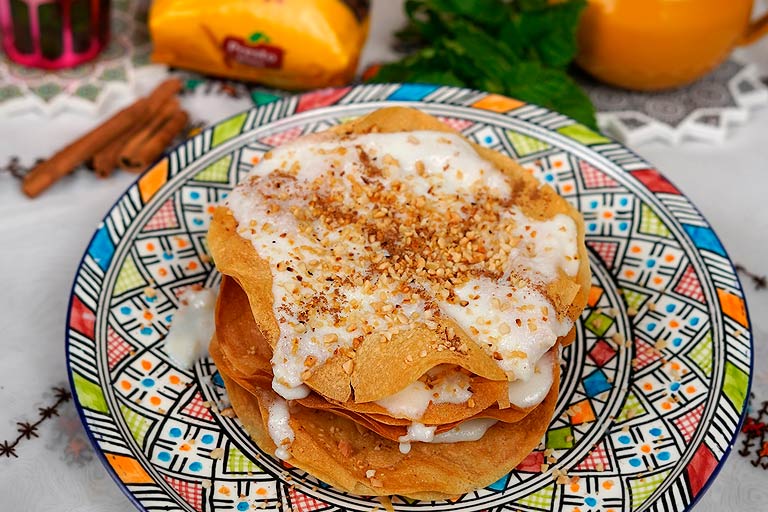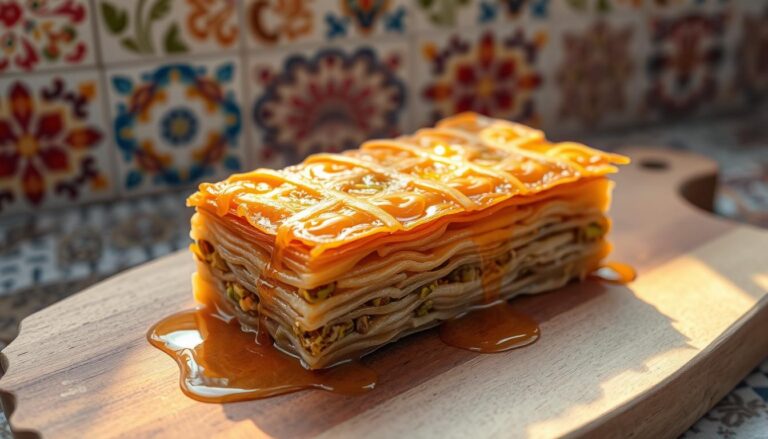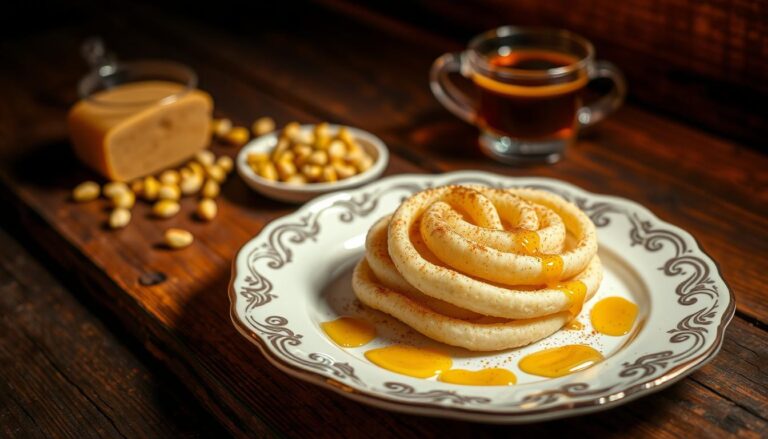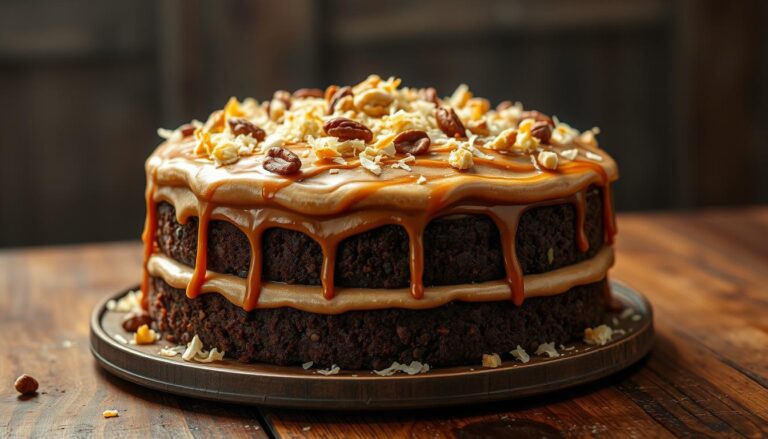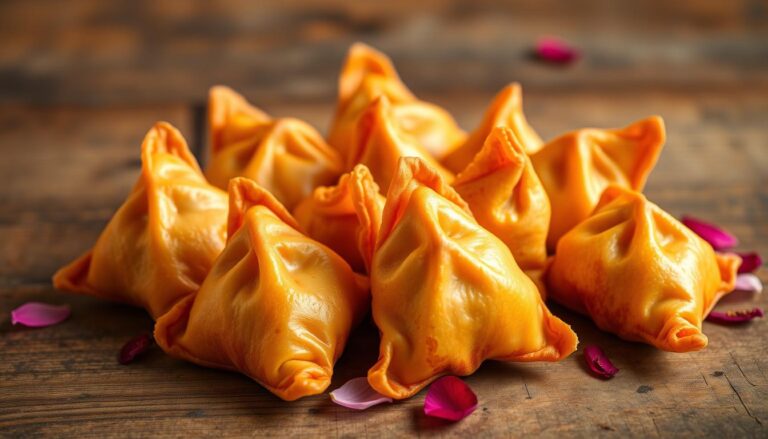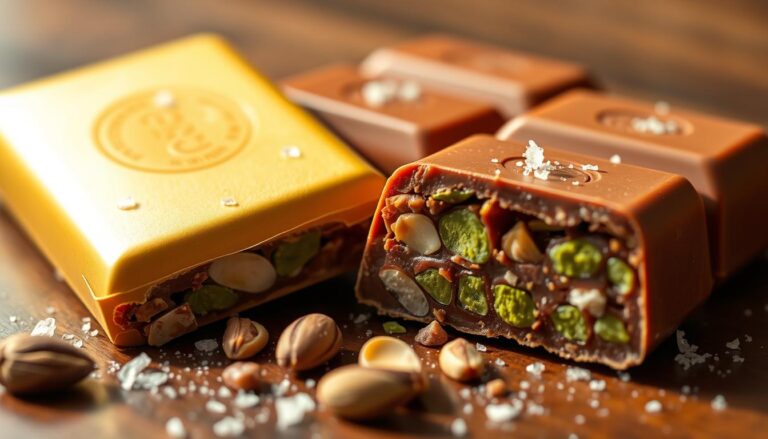Pastilla au Lait
Imagine a dessert that tells stories of Moroccan kitchens. Generations have perfected making something magical. Pastilla au lait is more than a dessert; it’s a culinary journey.
This treat has won the hearts of food lovers worldwide. It mixes the creaminess of milk with crispy pastry layers. This creates a dessert that’s both cozy and refined.
From the first bite, you’ll see why it’s a treasured dish. Whether you’re a pro in the kitchen or just curious, pastilla au lait offers a taste adventure. It takes you to Morocco’s lively streets.
Table of Contents
What is Pastilla au Lait?
Pastilla au Lait is a sweet Moroccan pastry loved by many. It has a unique texture and a rich cultural background. This dessert turns simple ingredients into a masterpiece that tells a story of Moroccan traditions.
Roots in Moroccan Culinary Tradition
The story of Pastilla au Lait is fascinating. It started as savory dishes with meat wrapped in pastry. Later, Moroccan chefs made a sweet version that became a favorite dessert in North Africa.
- Originated from traditional meat-based pastillas
- Evolved into a milk-based sweet delicacy
- Represents culinary innovation in Moroccan cuisine
Cultural Significance
Pastilla au Lait is more than a dessert in Moroccan culture. It stands for hospitality, celebration, and family. At special times like Eid and family reunions, it’s the star of the show, bringing everyone together with its comforting taste.
“Food is our common ground, a universal experience.” – James Beard
| Cultural Context | Significance |
|---|---|
| Family Gatherings | Centerpiece of social celebrations |
| Religious Festivals | Traditional dessert during Eid |
| Community Bonding | Shared experience of culinary heritage |
Every bite of Pastilla au Lait brings the warmth of Moroccan hospitality. It connects generations through a beloved tradition that continues to delight and inspire.
Key Ingredients in Pastilla au Lait
Making the perfect Moroccan milk pastilla needs the right ingredients. These ingredients turn simple parts into a creamy treat. Knowing what to use will help you make a dessert that’s both authentic and tasty.
The base of a great creamy milk pastilla is quality ingredients. The type of milk and other ingredients you choose greatly affect the taste and feel of the dessert.
Milk Varieties for an Authentic Experience
Choosing the right milk is key when making a Moroccan milk pastilla. Different milks change the dessert’s flavor and texture:
- Whole cow’s milk for a rich, traditional taste
- Goat’s milk for a tangy, unique flavor
- Almond milk for a dairy-free option
- Sheep’s milk for an extra creamy texture
Sweeteners and Flavorful Enhancements
The secret to a creamy milk pastilla is its sweeteners and spices. Moroccan recipes often use special flavors:
- Orange blossom water for a light, floral taste
- Ground cinnamon for a warm, spicy flavor
- Honey as a natural, sweetener
- Powdered sugar for a classic finish
Knowing these ingredients will help you make a Moroccan milk pastilla that’s truly special. It will take you on a journey through Morocco’s rich food culture.
How to Make Pastilla au Lait
Making a delicious homemade pastilla au lait is easier than you think. This recipe brings French culinary magic to your kitchen. You can create a creamy, delightful dessert that will wow your family and friends.
Before starting, get your ingredients ready and set up your workspace. Making a great milk pastilla recipe takes patience and detail.
Essential Ingredients You’ll Need
- Fresh whole milk
- Phyllo pastry sheets
- Granulated sugar
- Egg yolks
- Vanilla extract
- Butter for layering
Step-by-Step Preparation
- Warm the milk in a heavy-bottomed saucepan
- Whisk egg yolks with sugar until pale and creamy
- Slowly add warm milk to the egg mixture
- Return the mixture to the pan and cook until thickened
- Let the custard cool completely
Pro Tips for Perfect Texture
Here are some expert tips for making your homemade pastilla au lait:
- Use room temperature ingredients for smoother mixing
- Stir the custard constantly to avoid burning
- Layer phyllo sheets carefully to keep them crisp
- Brush each phyllo layer with melted butter
With practice, you’ll get better at this delightful milk pastilla recipe. It turns simple ingredients into an amazing dessert.
Variations of Pastilla au Lait
The traditional Moroccan dessert, pastilla au lait, is a canvas for creativity. The classic recipe is loved, but different areas have their own twists. These show off local tastes and ingredients.
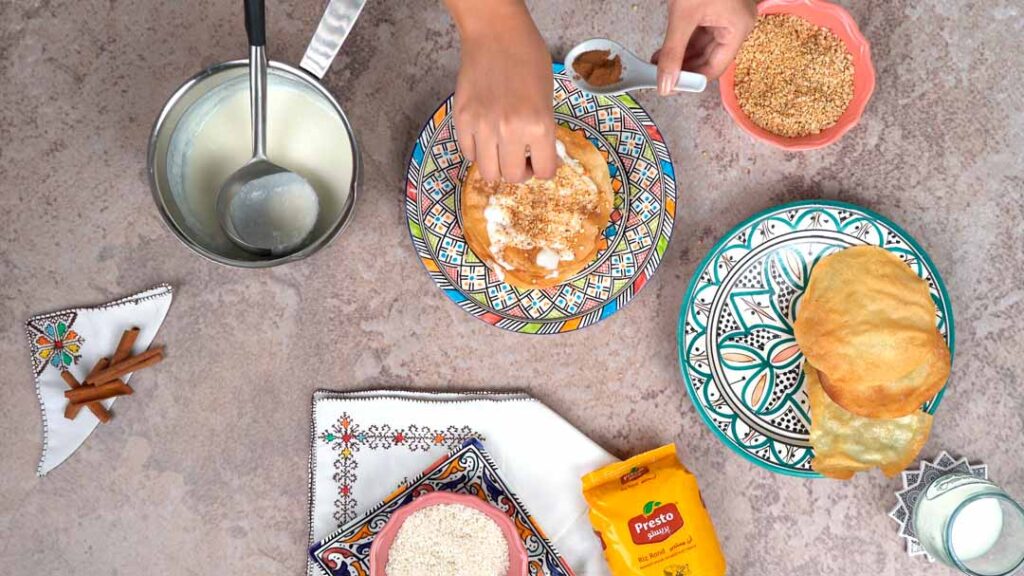
Transform your easy pastilla au lait with exciting regional twists. These reflect the rich diversity of Moroccan cuisine.
Regional Flavor Explorations
- Coastal regions often add orange blossom water for a fragrant twist
- Mountain areas might include local nuts like almonds or walnuts
- Urban centers try out modern flavor mixes
Popular Creative Twists
Innovative bakers have found tasty ways to change this classic dessert. Your pastilla au lait can get a boost with simple additions. These create amazing taste experiences.
| Variation | Key Ingredients | Flavor Profile |
|---|---|---|
| Chocolate Infusion | Dark chocolate, cocoa powder | Rich, decadent |
| Fruit Fusion | Mango, strawberry puree | Fresh, bright |
| Nutty Delight | Roasted pistachios, almond extract | Crunchy, aromatic |
Whether you stick to the traditional or like to try new things, pastilla au lait is full of possibilities. Each twist celebrates the dessert’s versatility while keeping its Moroccan roots.
Serving Suggestions for Pastilla au Lait
Make your sweet Moroccan pastry experience even better with these serving ideas. Pastilla au Lait is a versatile dessert that can be paired and presented in many ways.
Perfect Dessert Companions
- Fresh seasonal fruits like figs or pomegranate seeds
- Light almond cookies
- Chopped nuts for added texture
- Honey drizzle for extra sweetness
Beverage Pairings
Try these drinks to enhance your Pastilla au Lait:
- Moroccan mint tea
- Strong Arabic coffee
- Chilled orange blossom water
- Light espresso
Presenting your Pastilla au Lait can make it a stunning dish. Add powdered sugar, garnish with mint, and serve on fancy plates. This will bring the authentic Moroccan cuisine to life, pleasing both your eyes and taste buds.
Nutritional Information
Understanding the nutritional profile of Moroccan milk pastilla helps you make better choices. This dessert is not just sweet; it’s also packed with nutrients that boost your health.
The creamy milk pastilla has a good mix of macronutrients. It can be part of a healthy diet if eaten wisely.
Calorie Breakdown
A serving of Moroccan milk pastilla has 250-300 calories. The main sources of calories are:
- Milk: Gives calcium and protein
- Sugar: Adds sweetness and energy
- Eggs: Provides protein and healthy fats
- Flour: Offers complex carbs
Health Benefits
Even though it’s a dessert, Moroccan milk pastilla has some health perks:
- Calcium Boost: Good for bones
- Protein Source: Helps muscles
- Energy Provider: Quick and tasty energy
“Enjoying desserts in moderation can be part of a healthy lifestyle” – Nutritional Expert
Remember, it’s all about moderation with Moroccan milk pastilla. Enjoy it as an occasional treat that’s both tasty and slightly healthy.
Common Mistakes to Avoid
Making an easy pastilla au lait at home can be tricky. Even experienced cooks sometimes struggle. Knowing common mistakes helps you master this recipe.
When making your homemade pastilla au lait, several mistakes can ruin it. Knowing these errors will improve your cooking. It will also make sure your dessert tastes great.
Milk Cooking Challenges
Overcooking milk is a big problem for home chefs. The custard can turn grainy if the heat is wrong. Here are key mistakes to watch for:
- Cooking at too high a temperature
- Not stirring consistently
- Leaving the mixture unattended
Ingredient Ratio Precision
Getting the right mix of ingredients is key for an easy pastilla au lait. Wrong ratios can cause:
- Overly thick or thin consistency
- Bland or too sweet flavor
- Separation of milk and other ingredients
Pro tip: Always measure ingredients carefully and follow the recipe precisely. Small changes can greatly affect your homemade pastilla au lait’s texture and taste.
Patience and attention to detail are the secret ingredients to a perfect pastilla au lait.
Storage and Shelf Life
Keeping your traditional Moroccan dessert fresh is key. Your milk pastilla recipe needs the right care to stay creamy and flavorful.
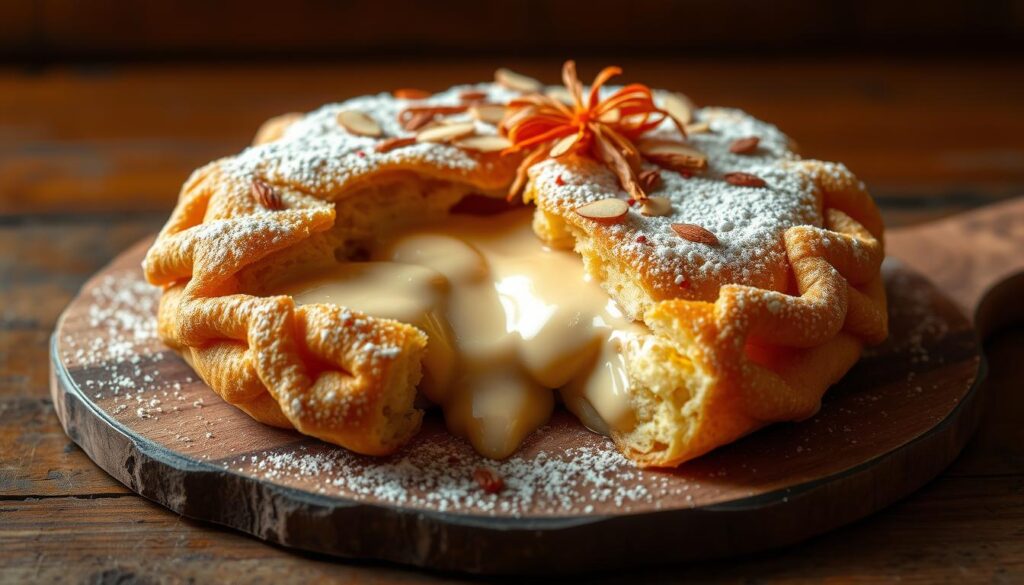
Storing your homemade pastilla right is essential. It helps keep it tasty for days after you make it.
Refrigeration Best Practices
Here’s how to store your milk pastilla recipe:
- Store in an airtight container
- Place in the refrigerator within 2 hours of preparation
- Use clean, dry utensils when handling
- Keep away from strong-smelling foods
Freezing Your Traditional Moroccan Dessert
Freezing can make your pastilla last longer. Just follow these easy steps:
- Cool the dessert completely before freezing
- Wrap tightly in plastic wrap or aluminum foil
- Place in a freezer-safe container
- Label with the date of preparation
“A well-stored pastilla is a delicious pastilla!” – Moroccan Culinary Wisdom
Ready to enjoy your stored pastilla? Here’s how to reheat it:
- Refrigerated pastilla: Consume within 3-4 days
- Frozen pastilla: Best used within 1-2 months
- Thaw in the refrigerator overnight
- Gently reheat at low temperature to preserve texture
Pro tip: Always check your pastilla before eating. If it smells bad or looks off, throw it away.
Conclusion: Enjoying Pastilla au Lait
Exploring Pastilla au Lait takes you on a tasty journey through authentic Moroccan cuisine. It’s more than a sweet treat; it’s a way to connect with rich traditions and bring joy to your kitchen.
Making Pastilla au Lait at home turns simple ingredients into something amazing. Your family and friends will love the effort you put into making this traditional Moroccan treat. It’s a chance to share a special moment and explore new flavors together.
The Joy of Homemade Treats
Mastering Pastilla au Lait means more than just baking a dessert. It’s about preserving a culinary art form. Each batch is a chance to get better and try new flavors. Your homemade version can become a unique dish that tells your story of cultural appreciation and creativity.
Sharing with Family and Friends
Serving Pastilla au Lait is a great way to share Moroccan flavors with loved ones. It’s perfect for any occasion, creating memories and sparking conversations about food, culture, and tradition.

